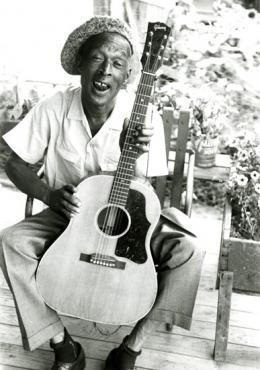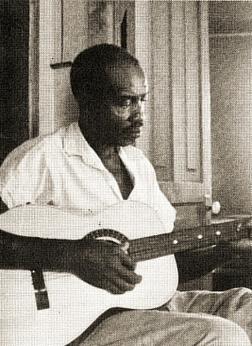Acoustic Blues Guitar Video Lesson Preview - CC and O Blues by Pink Anderson.
Pink Anderson is one of those blues men who was re-discovered during the folk-blues boom of the sixties,
 but due to illness never played at his previous level of skill. However, he made up for that in later years by singing slower tempo numbers that were simply stunning in their delivery and blues feel, such as the old blues classic 'Goin' Down Slow'. In earlier years his speciality was Piedmont ragtime guitar and his technique was fast, slick and highly syncopated.
but due to illness never played at his previous level of skill. However, he made up for that in later years by singing slower tempo numbers that were simply stunning in their delivery and blues feel, such as the old blues classic 'Goin' Down Slow'. In earlier years his speciality was Piedmont ragtime guitar and his technique was fast, slick and highly syncopated.
On many of his recorded tracks he is partnered by another blues guitarist, Simmie Dooley, which is the case with this track 'CC&O Blues'. The second guitar is capoed high on the neck so more syncopation and complexity if achieved while both men play relatively simple guitar parts.
Of course, most people became aware of Anderson due to the fact that Pink Floyd named their group after him and Floyd Council, even though the two blues men never met and didn't know each other! The story goes that the group had another name and one night, while waiting to go on stage, another group using their name was introduced.
They saw a blues guitar album on a table in the dressing room featuring Pink and Floyd, and they quickly re-named themselves before the gig - a legend was born! They were both from Carolina though - Pink from the South and Floyd from the North.
Different regions produced different styles of blues guitar ...
... and Carolina produced some of the finest ever heard - Willie Walker, Reverend Gary Davis, Floyd Council, and Blind Boy Fuller, for example. The style was basically Piedmont ragtime guitar, but was often not so light and introduced interesting variations and patterns not found in other styles.
Pink learned to play banjo and guitar as a teenager and started to earn his living quite early on in life, playing to the crowds attending the demonstrations of a traveling medicine show, which he joined in Carolina. He learned ragtime blues guitar and different tunings from Simmie Dooly and they teamed up to play in bars and at parties traveling around Carolina and neighboring areas.
It's clearly possible to differentiate between the two guitars played on CC&O Blues, but as I play alone nowadays, transcribing it posed a bit of a challenge. I wanted to make it accessible to one guitar player, but keep the flavor of the original. Pink's guitar is playing a type of melody on the higher treble strings , while Dooly is laying down an alternating bass pattern at a lower level.
I simulated the feel of this sound by using dropped D tuning, one advantage of which is that you don't need to fret the bass E string when playing D, or any of it's inversions higher up the fret board. This means that I can play the higher treble register in exactly the same way as Pink did, but also maintain a nice low alternating bass pattern which sounds like Simmie Dooley's part.
Although the chord progressions is difficult for the left hand - basically D plus it's inversions, G7 and A7 - it's the right hand which gives the song it's overall special feel, which is important as it transmits the impression of a train moving along, which is what the CC&O was - a train.
It was a popular them in those days, as the freight train represented a means of escape and it was free, if you could escape the railway police. Pink used a thumb and two finger for his picking, but I'm not sure if he used a thumb pick or not. I'm fairly sure he used more than one finger due to the way that the notes played on adjacent strings were played - they are just too fast to be played with one finger.
The dexterity shown when playing the D chord is particularly impressive - the picking finger follow each other rapidly while the left hand is lifting off and on the strings in the a very precise way, producing a clipped and raggy pattern which is very attractive.
